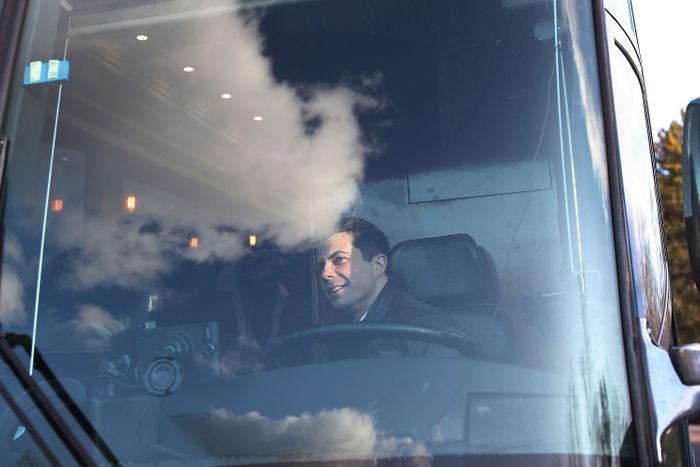
Transportation in the U.S. is facing a deep crisis. Congress is on the verge of doling out $45 billion in bailout funds across a half-dozen industries — and it still won’t be enough to keep the country’s trains and planes financially stable. Entering office as such a crisis has the potential to threaten the economic livelihood of every American, from deferred car payments to slashed bus service, Joe Biden has nominated someone as Transportation secretary who arguably has no experience running such a department: former mayor of South Bend, Indiana, Pete Buttigieg.
Running the Department of Transportation has been conventionally viewed as a role that’s much more about overseeing regulators of multimodal movement: ports, highways, airports. So much so that some might argue it doesn’t matter much who runs it when it comes to changing policy. But Biden — if we take him at his word — cares an unusual amount about the health of the country’s transportation system. Last week, as the news leaked that Trump was orchestrating a dramatic Air Force One departure with another shot-by-shot recreation of Triumph of the Will, Biden’s team was planning for the president-elect to return to Washington, D.C., the way he left in 2017, on an Amtrak train. Never has the contrast been more symbolic: from a near-dictator hopping one final (we hope) fossil-fuel-powered ride on a private aircraft to a longtime public servant riding the same kind of publicly subsidized, low-emission transit he’s used for four decades, 259 miles round-trip, more than 8,000 times.
So why did Biden, known for so heavily favoring one particular way of getting around that it became his nickname, pick someone to head the department who is not an expert at his pet-policy area? Even though this administration has been marked by cabinet appointments that appear arbitrary, the vetting process for the DOT role seemed to be closing in on at least one highly qualified candidate: Sarah Feinberg, former administrator of the Federal Railroad Administration and current interim director of New York City Transit, who had recently been reappointed to Amtrak’s board (although the Republican-led Senate never confirmed her, along with many other federal appointees). Instead … Buttigieg.
As the mayor of a city with a population smaller than the number of people who enter the Times Square subway stop each day, Buttigieg certainly does not have any qualifying administrative experience. But he has, through his own presidential run, demonstrated a firm grasp of the issues at stake for Americans. When he was Biden’s opponent in the primary, he assembled his own $1 trillion infrastructure plan, including one element none of his opponents had: a nationwide Vision Zero campaign to eliminate traffic fatalities. He talked informedly about sprawl reduction as a climate-mitigation measure and the need to reduce car dependency. In South Bend, his eagerness to implement complete streets programs garnered national attention, including a program called “Smart Streets” that transformed the city’s downtown business district into an urbanist utopia of separated bike lanes and brick-paved sidewalks (which were attacked, funnily enough, by a Biden campaign ad). But when his safe-streets program resulted in the death of an 11-year-old boy who was killed while crossing the street where a traffic signal had been removed, Buttigieg defended the program’s data instead of reaching out to the Black community where it happened. (“Pete has a Black problem,” said Ohio representative Marcia Fudge after a local police shooting in June. She will presumably be his fellow cabinet member, as HUD secretary.) Those frayed relationships, along with Buttigieg’s longtime relationship as a consultant with McKinsey, has led some to worry that he’s planning to privilege private and corporate interests over people.
But Buttigieg may not need a big vision, because his boss has one. Whereas Trump came into office promising a nonexistent building program that never manifested itself beyond the Infrastructure Week gag, Biden’s transportation platform is, arguably, one of the most comprehensive policy frameworks the department has ever had. If it’s paired with the aggressive climate mandate that will reportedly be run by former EPA chief Gina McCarthy and he’s held accountable by advocacy groups that have already started to skillfully exert pressure, Biden has a real opportunity to bolster the recovery of every community, create vast numbers of jobs, earnestly confront this country’s racial inequities, and dramatically overhaul a sector of the economy that currently produces one-third of U.S. emissions. Buttigieg, in this role, principally needs to be a true advocate for the people that this country’s transportation department has long neglected, starting by surrounding himself with train commuters, bike messengers, and bus riders. Maybe Secretary-in-waiting Pete, who has proven to be a solid — and sometimes disarmingly aggressive — surrogate for Biden on the campaign trail, can deliver the transportation vision of Amtrak Joe. As long as it’s not from the backseat of an SUV.




